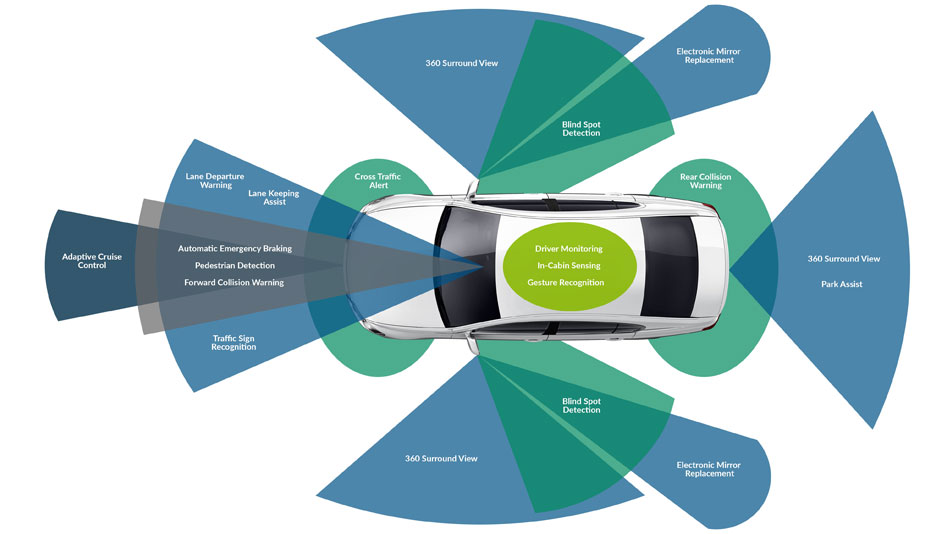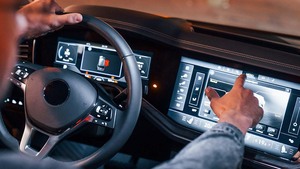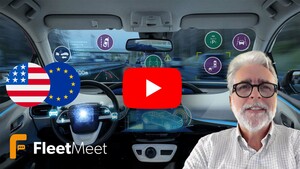What is an Advanced Driver Assistance System (ADAS)?
Advanced Driver Assist Systems (ADAS) come in many forms: from systems that apply the brakes if they sense an imminent crash (Autonomous Emergency Braking) to ones that help maintain a constant distance from the car ahead (Adaptive Cruise Control) to others that help keep the vehicle in the lane (Lane Keep Assistance).
They operate using a wide range of technologies from cameras, to radars and lidar systems which when required can operate both independently and in fusion with other systems that help to identify and avoid potential hazards either by warning the driver, or by automatically taking over an element of the vehicle such as braking, or steering if the driver doesn’t react.
ADAS have a key role to play in reducing the number of vehicle collisions on the road. In the past 5 years, there has been a 10% fall in the number of road accidents, as the technology has improved to keep drivers safer.

What are the main benefits of ADAS to drivers and companies?
- Helps to drive down costs (fewer accidents = less money spent)
- Improves road safety for everyone
How do they drive down costs?
- Fewer and less severe accidents should reduce the amount of damage to vehicles / cost of repairs.
- Less severe accidents reduce the amount of time a vehicle spends off road (which in turn means less money spent on replacement/temporary vehicles.)
- Improved road safety reduces the risk of injury to staff.
- Some insurers offer reduced costs/discounts for vehicles fitted with ADAS.
- Fewer claims can help to improve your insurance premium.
So why aren’t ADAS standard on every vehicle?
The European Parliament has backed the idea that all vehicles sold in Europe should be fitted with certain life-saving technologies as standard. The number of safety measures is increasing all the time. But not all vehicles have these features as standard. It is something you should consider when creating a benchmark for your vehicle policy.
New regulations on vehicle safety standards in the EU, due to come into force in 2022, were provisionally agreed in Strasbourg on March 25th 2019. Under a wide-ranging set of rules known as the Third Mobility Package, the European Commission described a vision of connected vehicles and digitised roads.
New features that will be standard by 2022
- Advanced emergency braking (cars, vans)
- Alcohol interlock installation facilitation (cars, vans, trucks, buses)
- Drowsiness and attention detection (cars, vans, trucks, buses)
- Distraction recognition / prevention (cars, vans, trucks, buses)
- Event (accident) data recorder (cars, vans, trucks, buses)
- Emergency stop signal (cars, vans, trucks, buses)
- Full-width frontal occupant protection crash test – improved seat belts (cars and vans)
- Head impact zone enlargement for pedestrians and cyclists -safety glass in case of crash (cars and vans)
- Intelligent speed assistance (cars, vans, trucks, buses)
- Lane keeping assist (cars, vans)
- Pole side impact occupant protection (cars, vans)
- Reversing camera or detection system (cars, vans, trucks, buses)
- Tyre pressure monitoring system (vans, trucks, buses)
- Vulnerable road user detection and warning on front and side of vehicle (trucks and buses)
- Vulnerable road user improved direct vision from driver’s position (trucks and buses)
ADAS should form part of your vehicle policy and Occupational Health, Safety and Environment should be part of the process to help define a policy designed to improve driver safety where possible. Fleet360 believe that every accident, that could have been avoided by technology or proper human behaviour, is one too many. Therefore, if you are about to tender or if, for your new vehicle orders, you would like to get insights in the business case for installing ADAS as minimum vehicle requirements.



